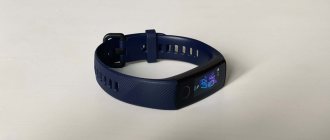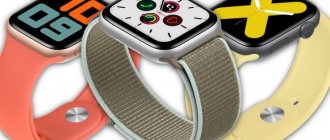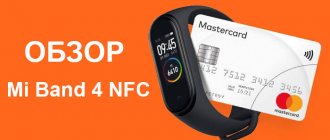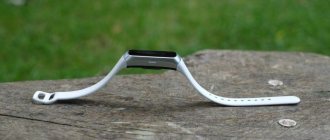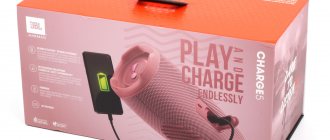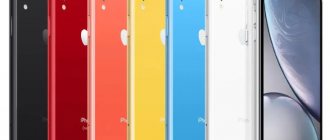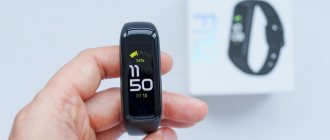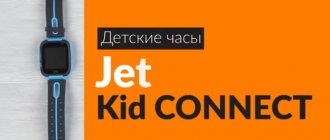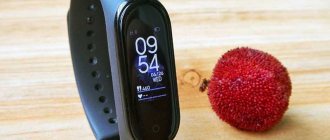The Fitbit Charge 5 is a good fitness tracker that should be the best, but it's too expensive for a fitness tracker and lacks functionality when compared to a smartwatch.
Since the release of the first Fitbit Charge in 2014, Fitbit's annual releases have featured simple designs and monochrome displays. What has changed with the release of Charge 5 and whether the price of the new tracker is justified can be found out in my review.
Fitbit Charge 5 specifications
| Screen | Color touch OLED, 14.7×21.9 mm, refresh rate 60 Hz |
| Autonomy | Stated: up to 7 days In practice: 3 days with maximum settings |
| Tracking | Heart Rate EDA SpO2 Sleep Training Skin Temperature |
| Communication and Connection | Bluetooth, NFC |
| Navigation | GPS, GLONASS |
| Water resistance | WR50 (up to 50 m) |
| Applications | Yes |
| Smartphone notifications | Only reading |
| Sensor | Accelerometer, body temperature measurement, built-in heart rate monitor, ECG |
| Colors | Steel blue, platinum, black, graphite, moon white, gold |
| Price | 20 thousand rubles |
What you need to know about Charge 5?
The Fitbit Charge 5 release date is August 25, 2022. The tracker retains most of the features of previous models, including heart rate and SpO2 monitoring, pedometer and sleep quality assessment.
Unfortunately, there is no altimeter. But for the first time in the Charge line, an EDA (electrodermal activity) sensor appears to determine the body’s stress level and monitor skin temperature. The new product includes some smartwatch functions, including receiving notifications from your phone, the ability to read messages, and more.
Support for the Fitbit Pay payment system allows you to use NFC to pay for goods at store checkouts. There are no music controls, however. It should be noted that for free you only get access to the basic functions of the tracker. The good news is that with purchase you get a free six-month trial of Fitbit Premium.
The Charge 5 comes in a stainless steel case in three color options: Graphite case with a black strap (used for the preparation of the review), Soft Gold case with a white strap (Lunar White) and Platinum case with a blue strap (Steel Blue).
Fitness and training
The new Fitbit Charge 5 tracker supports 20 types of workouts, including running, swimming, cycling, yoga and more.
However, only six can be displayed at all times, just like the Charge 4. To track more types of workouts, you'll have to manually change them using the Fitbit app, which doesn't add convenience. Sense and Versa 3 do not have this limitation.
Charge 5 is also missing two important features. Firstly, unlike the Charge 4, there is no altimeter. Without this hardware feature, it's impossible to keep track of the number of floors you've climbed, and it won't be particularly accurate to monitor uphill and downhill workouts, such as walking. An unpleasant omission.
Secondly, there is no real-time recording of training laps. Fitbit Versa 3 and Sense let you add a dedicated circuit training button to the display. This isn't possible on the Charge 5, but you can manually add post-workout laps in the Fitbit app. For an expensive fitness-focused device, the feature seems necessary.
Design
Fitbit Sense is a logical continuation of Fitbit Versa 2. The new product is made of similar materials, but significantly improved in many aspects. The design of the new device uses steel and aluminum - it is not inferior to the Apple Watch in terms of assembly. The front side is occupied by a 1.58-inch AMOLED screen, which, in comparison with its predecessor, has become slightly wider. The display is easy to read in direct sunlight and has good viewing angles. Yes, it has tangible bezels, but they are not as large as the previous model.
Instead of a physical button on the left side of the case, an inductive one is used. The Fitbit Charge 3 and Charge 4 had the same one - now it serves to return to the home screen. This type of control elements has an interesting idea, but in practice they can hardly be called convenient.
Fitbit Sense comes with a strap that resembles the standard fluoroelastomer band on the sports Apple Watch. It is not very convenient to fasten it, but it looks good and practically does not collect dust. It is very easy to replace it with an alternative, of which there are plenty in online stores.
Fitbit says Sense can last up to six days without using GPS, a feat that can only be achieved by being mindful of the features you use. In real life, their autonomy usually reaches five days - if you activate the always-on screen, it will be reduced to two. By the way, the watch is charged using a new magnetic charger - it takes approximately 40 minutes to replenish the energy reserve from 10 to 80%.
Heartbeat control
All-day heart rate tracking on the Fitbit Charge 5 is as accurate as its predecessors.
Mean resting heart rate measurements were consistent with finger-clamp pulse oximeter readings. However, at the beginning of training, the tracker sometimes recorded a heart rate much higher than the real one. Even at rest with a heart rate of about 50 beats/min, the tracker overestimated the readings, sometimes exceeding 100 beats/min. After a few minutes, the readings slowly decreased, approaching the real heart rate.
The Fitbit team explained that the Charge 5 ticks a certain number of times per hour to get average heart rate data, and much more frequently during exercise to improve accuracy. Perhaps a short-term jump is caused by a change in regime (rest/training), and so far the reason has not been found. It is possible that this is a one-off problem, since the device used for review was not intended for retail sale.
Otherwise, heart rate recording during exercise works well. The graph below compares the results obtained while cycling using the Charge 5 and the Wahoo Tickr X chest strap: The graphs are very similar. Even the recorded average and peak heart rates are very close.
Bottom line
The Fitbit Charge 5 is a good fitness tracker with features that most other competitors don't have, such as an EDA scanner and NFC payment support. Equipped with a bright full-color OLED display, which makes it aesthetically and functionally better than its predecessor.
However, the noticeable increase in price doesn't give you a better fitness tracker overall. A color display is better than a monochrome display, but it comes at the expense of battery life and an altimeter. And how much does an average person need an EDA scanner?
Is it worth buying
For its price, the Fitbit Charge 5 should be the best fitness tracker and has all the features you need to track any kind of workout. Battery life and health tracking performance are not good enough. All promoted features are not yet available at launch, so Charge 5 does not meet these requirements.
In my opinion, you're better off with the good Versa 3 smartwatch. Or spend a fraction of that on the Xiaomi Band 6. The Charge 5 occupies a weird middle ground and is hard to recommend to anyone other than Fitbit fans.
Yandex Market
Step counting
Fitbit is notorious for inflating step counts on its devices.
Simultaneous use of the Fitbit Charge 5 bracelet (on the right wrist) and Fitbit Sense (on the left) confirmed this: Charge 5 recorded several hundred more steps every day. Therefore, tracking steps using the Charge 5 will be less accurate than using a dedicated pedometer. However, this accuracy is sufficient for most people.
Monitoring sleep, SpO and skin temperature
The Fitbit Charge 5's sleep monitoring data is accurate and easy to understand. The Daily Sleep Score tells you how well you slept the night before.
Interestingly, this measure does not always correlate with sleep duration, and the estimate may be higher for shorter periods of sleep. Overall, the Fitbit app's sleep ratings were fairly consistent with how I felt.
Fitbit recently introduced a way to track snoring using its Sense and Versa 3 devices. The Charge 5 doesn't have this feature because it doesn't have the microphone needed to monitor snoring.
It is still possible to monitor SpO2 (blood oxygen saturation level). Comparison with pulse oximeter readings confirmed the sufficient accuracy of the measurements.
Additionally, Charge 5 can track skin temperature. Due to the lack of special equipment, this is only possible in automatic mode during sleep. However, hearing about sudden changes in average skin temperature may indicate that you are getting sick.
Voice control
Fitbit's Versa 3 works with Alexa. With your voice you can set a reminder, timer, start a run, control smart home devices, check the weather and ask questions.
By default, calling Alexa is done by pressing the button on the left, however, the key can be reassigned. Fitbit Versa 3 has a built-in microphone that only turns on when communicating with an assistant. If you're concerned about privacy, you can turn off your microphone altogether.
According to Fitbit, the Google Assistant will be added to the watch by the end of the year, and the company also plans to add the ability to answer phone calls through Versa 3.
Stress tracking
For the first time, EDA sensors appeared in the Fitbit line of Sense smartwatches. Fitbit Charge 5 uses the Luxe beat-forbeat system.
Lightly pressing your fingers on two thin metal strips on the sides of the body triggers a scan, during which the tracker tracks changes in your sweat rate over several minutes.
Daily scans at different activity levels (pre-workout, post-workout, before bed, etc.) provide insight into normal and elevated stress levels. This accumulated stress data feeds into Fitbit's new Daily Readiness Score feature, discussed below.
GPS sensor operation
Unlike the Fitbit Luxe, the Charge 5 comes with built-in GPS. To save energy, it is also possible to receive location data from a smartphone's GPS.
You can choose one of these two types of GPS tracking for all workouts, or dynamic GPS, which allows the tracker to switch between its own sensor and the phone's sensor depending on the quality of the connection.
The Charge 5's GPS tracking quality does not disappoint. Comparison with the Wahoo Tickr X chest strap GPS showed almost identical results. At first, it took Fitbit quite a while to connect to GPS, but this is typical for wrist trackers due to their small size compared to smartphones and chest straps.
So, if you are a fan of GPS tracking, then the Fitbit Charge 5 will suit you just fine.
Fitbit app
The release of Fitbit Charge 5 did not change the appearance or operation of the app. Overall, this is a well-designed software with an intuitive interface.
However, one of the main features of the Charge 5 is not yet available in the Fitbit app. Namely, the Daily Readiness Score (DRS), which was an important aspect of Fitbit's advertising campaign for the new tracker. Fitbit has only said that DRS is coming soon, and that the feature will come to other trackers, including the Sense, Versa 3, Versa 2, Luxe and Inspire 2.
It is assumed that DRS will collect all the data that the tracker receives - sleep quality, workouts, stress levels and others - and combine them into easy-to-understand blocks. For example, if you did not get enough sleep the night before, you will be advised to skip your morning workout, and if your stress level is high, you will be advised not to exert yourself for the rest of the day. Conversely, if you slept very well, you will be advised to intensify your workout to achieve maximum results.
This type of reporting has been successfully implemented by other companies; for example, Body Battery from Garmin has been around for several years. In this sense, Fitbit is late to the game by promoting a tracker that, in theory, works with this system. Unfortunately, releasing products without promised features is common practice for Fitbit.
So there's nothing really new in the app yet related to the Charge 5. One final note: DRS features will only be available with a Fitbit Premium subscription. In addition to DRS, Fitbit Premium provides deeper sleep analytics, meal plan support, workout guides, and more.
However, none of the hardware features are locked into Premium, so it's wise to wait until DRS is available before purchasing the Charge 5 to avoid missing out on your six-month free trial of DRS.
Autonomy
Fitbit says the Ionic lasts about 5 days on a single charge and about 10 hours with GPS. These data are confirmed by our measurements, the only thing is that the autonomy is still affected by the style of use and how often the user plays sports with active GPS. For example, if you run 10 km every day, then you will need to charge the Ionic every 3 days. The watch is connected to the charger via a magnetic connector. They require 2 hours to fully charge when discharged.
4
ITC.UA rating
Pros: nice design, quality materials and workmanship, complete strap, high-quality display, convenient controls, interface speed, water protection, built-in GPS, heart rate monitor, convenient Fitbit application, sleep tracking, good battery life
Cons: Cyrillic is not supported in notifications, few applications, slow GPS start
Conclusion: Fitbit Ionic is a sports watch that can track the user's physical activity, sleep, and sports activities. Unfortunately, despite the relatively large display, powerful platform, and support for installing applications, the Fitbit model is inferior in functionality to smartwatches from Apple and Samsung. There are no interesting programs from third-party developers for Ionic, and notifications do not support Cyrillic. In this regard, I would like the Ionic to be more similar to the Pebble, but Fitbit seems to have completely buried these developments. Otherwise, the watch does its job perfectly; you can run, ride a bike, swim in it, measure your heart rate, analyze your sleep in detail, and give useful health recommendations.
Specifications
Smart features of Fitbit Charge 5
The appearance of a full-color display made the Charge 5 look like a smartwatch. Let's see what he can do.
You can receive notifications from your smartphone. Your device displays emails, text messages, and phone calls. On the bracelet, you can read most of the text message or remove it from the notification list of both the tracker and smartphone (at least on Android). However, you will not be able to reply to messages.
The expected features are present, such as setting alarms and timers, as well as Fitbit Pay for paying for purchases at store checkouts without a smartphone, thanks to the built-in NFC. What can he no longer do?
There's no music control feature, although the Charge 4 did have access to Spotify controls. You can't store music on your wrist either. There is no built-in digital assistant, weather, or third-party apps. The good news is that the Fitbit Versa 3 has all these features and costs almost the same.
Fitbit Versa 3 Review: A Powerful Combination of Great Battery and Features
The Fitbit Versa 3 is no longer the company's flagship, but it is a much more versatile offering at an affordable price with great battery life. We decided to conduct a detailed test of the device and find out what Russian consumers are missing out on, given the absence of Fitbit in our market.
When Fitbit launched the Versa, it was marketed as a "smartwatch for the masses," and along with the health-focused Fitbit Sense, that's still true today.
Fitbit has strived to improve the design of the gadget, equipped the new product with built-in GPS (which was previously only found on the Ionic), and the latest heart rate tracking technology to offer more accurate health and fitness data.
During the review, we will find out whether Fitbit smartwatches are still popular for the mass user and what exactly Russian consumers are deprived of.
Design and software
It seems that, having finally buried the Ionic model, Fitbit is betting on smartwatches in a square form factor, similar to the Apple Watch.
In our opinion, the device is more suitable for the fair half of humanity, however, with a certain combination of straps and dials, it looks great on a man’s hand. Another positive point was the absence of radical changes in the design of the Versa 3. There are three colors available to choose from and a large number of straps made of different materials. At the same time, replacing straps has become easier, thanks to the modified fastening. Because of this, straps from the second generation will not fit.
The 40mm case is slightly larger than the 39mm, and the thickness has been increased from 12.15mm to 12.35mm. The increase in size and volume isn't really that noticeable and they still look great.
Fitbit Versa 3 (left) and Fitbit Sense (right)
Fitbit's increased body size has also been used to increase the size of the display. It's now a 1.58-inch AMOLED display with an improved resolution of 336 x 336. The Versa 2 has a smaller 1.39-inch screen with a resolution of 300 x 300 pixels. So the new product has a truly high-quality display, sharp, bright and with excellent viewing angles.
The new display is equipped with an Always-On mode (always on display). True, this has an impact on autonomy.
There is one physical button on the case. It is made hidden, which should improve the design, but it is not convenient to use. It is quite rigid and does not always respond from the first press, forcing you to press too hard. Luckily, it's not often needed to navigate menus.
| — Read more: BEST SMART WATCHES FOR ANDROID OWNERS: WEAR OS AND AN ALTERNATIVE |
The water resistance rating has not changed compared to the second generation, and also allows the gadget to be used for swimming.
I would like to say a few words about software design. We liked the design of the applications and the simplicity of the software. With the growth of functionality, software design has lost its ease. There were some delays when flipping through screens and opening applications. And the menu responds slowly. It's not critical, but it's not pleasant.
Subjectively, the daily statistics section is overly dominant.
Main characteristics:
|
Smart features
In general, I would like to note that the gadget has good smart functions.
The smartwatch worked well with both iPhone and Android smartphones. Occasionally there was a problem with synchronization, but the connection was quickly restored.
Work with notifications is available as standard. At the same time, the notification delivery time is minimal. For Android smartphone users, there is even the option to respond with a voice message, message templates, or emoticons. Everything works without problems.
Great news - storage of your own music and offline playlists. But only Deezer. At the same time, turning on music is still inconvenient. Unfortunately, there is no support for playing streaming music from Spotify. It's a pity.
Fitbit Pay also works, but again without Russia.
The company also has its own store of applications and watch faces, reminiscent of Garmin. It's more limited, slower, and less user-friendly, and it takes a long time to install and update apps. But he is...
| — Read more: CONTACTLESS PAYMENT SYSTEMS FOR SMART WATCHES |
Support for Amazon's Alexa voice assistant has also been retained. It works just as well as on second-generation smartwatches, but is completely useless for Russian-speaking users. For others, the assistant is activated by the side button (after syncing your Amazon account with Fitbit). You can get answers, control your smart home, set reminders, and much more.
For those who are not comfortable working with Alexa, the company has implemented support for another voice assistant - Google Assistant. It is stated that the assistant can be used to answer incoming calls, but this can only be done when the smartphone is within Bluetooth range. But it was not possible to test this function. So far it turned out to be unavailable on the test copy.
Health and activity monitoring
This is the strong point of Fitbit Versa 3 is one of the best gadgets for tracking activity and sleep.
24/7 physical activity monitoring is available, including steps, breathing exercises and women's health monitoring. You can track your heart rate, manually enter weight data, the amount of food and water consumed. In order to calm down, there is a whole set of meditation tracks. Note that most of the functionality is available with a paid Fitbit Premium subscription. Detailed health analytics (respiration rate, blood oxygen saturation, heart rate variability) are also available with a paid subscription.
Sleep tracking
Comparing sleep monitoring accuracy: Fitbit Versa 3 (left) and Garmin fitness tracker (right)
The developer's controversial decision was to divide steps, floors overcome, and distances into separate sections in the application. In our opinion, it is much more convenient to collect all this data in one place.
The gadget motivates the user with hourly notifications about low activity. It's simple, but it works flawlessly. I want more motivational actions, similar to Samsung, Huawei and Garmin.
Sleep monitoring comparison: Fitbit Versa 3 (left and center) and Garmin fitness tracker (right)
Sleep tracking is one of the manufacturer's strong features. And this feature is perhaps the best on the market. This is relevant both for the volume of recorded data and for the number of metrics.
The smartwatch records data on sleep disorders and has a built-in SpO2 sensor to monitor blood oxygen levels. Metrics can help identify breathing problems during sleep. But not sleep apnea.
| — Read more: SLEEP TRACKING. REBOOT 2020 |
You can view heart rate data during sleep and record moments of restless sleep. But this data is also available only to subscribers with Premium accounts.
The data tracking process and the amount of sleep information recorded, even in the free version, is significant, even compared to Garmin.
Compared to the Garmin tracker, the Versa 3 did a better job of recognizing bedtime and wake-up times.
It’s a pity that the new product lacks detailed health data. There is no ECG, temperature measurement or built-in EDA sensor to provide deeper insight into stress conditions.
Sports monitoring and heart rate monitor accuracy
Fitbit is looking to improve user activity tracking beyond just tracking steps. Added built-in GPS sensor. Let us remember that until recently, Ionic was the only smartwatch from the company with built-in GPS.
In addition to GPS, Versa3 received an accelerometer and PurePulse 2.0 heart rate sensor, with increased tracking accuracy.
The user has access to training intensity maps, which clearly demonstrate in which area the athlete puts the most effort during running or cycling.
Monitoring active heart rate zones helps keep your heart rate regular.
A significant advantage compared to some classmates was synchronization with third-party platforms such as Strava.
Sports monitoring is carried out in the Exercise application, which includes running, cycling, golf, hiking, swimming and spinning. Some are even available with SmartTrack automatic activity recognition technology. Naturally, the largest number of metrics are available for running and swimming.
Of course, this is not a Garmin or Apple Watch. The Versa3 was not designed for marathons or triathlons. But the capabilities of a smartwatch are quite enough for those who like to jog several times a week, swim, and even workout in the gym.
Run
With the addition of GPS, it became possible to go for a run without a smartphone. Finding satellites does not take much time, just like the Garmin Forerunner 745 with which we compared it. Several simple indicators are available to the user. To see them all, just touch the screen.
When comparing tracking accuracy, we note that the new product recorded a slightly shorter distance compared to the Forerunner 745. Accordingly, there were deviations in the pace. The data is not the most accurate and is unlikely to be suitable for professional athletes. But joggers will be able to forgive the watch for such inaccuracies.
Swimming
Swim monitoring comparison: Fitbit Versa 3 (left and center) and swim tracker (right)
I was pleasantly surprised by the AMOLED screen, which is perfectly readable in water. It's crisp, bright and has deep blacks.
Like running, swimming monitoring has basic metrics displayed on the watch screen.
In terms of accuracy, the trend continues: the watch records slightly less compared to the swimming tracker. Slightly less distance and length.
Accordingly, the Versa3 can be used for swimming monitoring, but not at a professional level.
Heart rate monitoring
Heart rate monitor comparison: Fitbit Versa 3 (left and center) and Garmin HRM-Pro chest heart rate monitor (right)
Fitbit uses new heart rate sensor technology. They are still optical, however, the accuracy should become higher. This partly explains the lack of ability to connect external heart rate sensors.
In terms of training tracking, the accuracy of heart rate data has increased compared to the previous generation. For steady-speed runs or steady-paced rowing, the accuracy was really good. With interval training, the difference with a chest heart rate monitor is expected to increase. Example above. The data shows a higher maximum value compared to the chest strap, as well as minor dips in other modes.
Delays in data readings with increasing intensity are primarily related to the specific operation of optical sensors, which we wrote about in detail in a special review.
Autonomy
The company's devices traditionally have excellent autonomy. And the third Versa was no exception. This sets the company’s gadgets apart from competitors such as Samsung, Apple and the army of Wear OS gadgets.
The manufacturer claims six days of battery life, depending on the intensity of use.
Adding a fast charging function only increases interest in the gadget. So, in 12 minutes of charging, you can get a whole day of use.
When testing smartwatches, the performance turned out to be similar to the declared ones. Versa3 required charging after 5 and 6 days of use (without using the always-on display and notifications mode, and with GPS 2-3 times a week). With AOD mode, battery life is reduced to two days.
GPS here is more power hungry compared to sports watches. During the test, a consumption of 8-9% was recorded for 30 minutes of operation. So, the 12 hours of GPS operation declared by the manufacturer is also real.
I really liked the fast charging. After 15 minutes of charging, the battery was charged from 18% to 44%.
Bottom line
Versa 3 is an evolution of the previous generation model. Smartwatches currently top the lineup along with Sense. The design has become better, the capabilities of the gadget have increased. Smart features are reliable and work without major glitches.
The addition of GPS did not make them a serious tool for the professional athlete.
If the user has enough data on activity, basic metrics of running and other sports, then this is an excellent choice for those who are not afraid of the lack of Russian language and support.
What I liked:
- Attractive appearance, large screen;
- Reliable activity tracking;
- Long battery life.
What I didn't like:
- Inconvenient button;
- Limited functionality without a paid Fitbit Premium subscription;
- Increasing complexity of software due to increased functionality;
- Poor performance in certain modes.
| — Learn more about Fitbit gadgets |
Source: wear-gadget
_________________
- join us on Facebook
— Our channel in Telegram
- we are on Instagram
